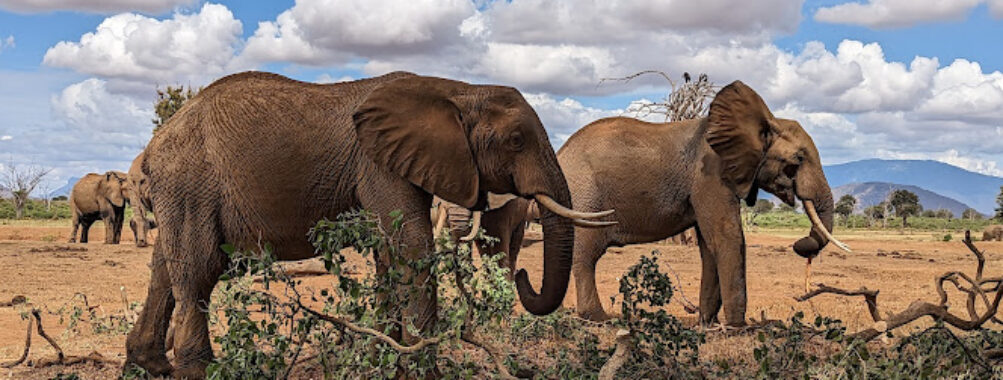
Tsavo East National Park
Table of Contents
Description
Tsavo East National Park is one of those places that just sticks with you, even long after you’ve left. Sprawling over a jaw-dropping 13,747 square kilometers, it’s not just big – it’s massive. The kind of massive where you can drive for hours and still feel like you’ve barely scratched the surface. Known for its raw, untamed beauty, it’s home to elephants dusted in the park’s signature red soil, lions with a bit of a legendary past, and an astonishing variety of birdlife that could keep any birder happily glued to their binoculars for days. Sure, not every moment here is picture-perfect – sometimes the heat is relentless, sometimes the wildlife plays hard to get – but that’s part of the charm. This is real Africa, not a curated postcard. And for many travelers, that’s exactly what makes it unforgettable.
There’s a certain stillness that settles over the plains in the early morning, when the air is cool and the golden light stretches across the savannah. That’s when you might catch sight of a shy kudu or hear the distant rumble of elephants making their way to the Galana River. It’s not just about ticking animals off a list – it’s about feeling the rhythm of the place. And if you’re anything like me, you’ll find yourself slowing down, breathing deeper, and maybe even forgetting about your phone for a while. The park is accessible, family-friendly, and surprisingly well-equipped without losing its wild edge. Think picnic tables under acacia trees, clean restrooms where you actually need them, and trails that are doable for little legs without sacrificing the thrill of being out in the bush.
Key Features
- Vast wilderness covering 13,747 sq km – one of Kenya’s largest protected areas
- Famous for red-dusted elephants and the legendary maneless lions of Tsavo
- Over 500 bird species for birdwatching enthusiasts
- Galana River with scenic Lugard Falls and crocodile sightings
- Guided walks and kid-friendly hiking trails
- Wheelchair accessible entrances and parking
- Picnic areas with tables and shaded spots
- Public restrooms conveniently located
- Payment options including credit, debit, and NFC mobile payments
Best Time to Visit
If you want my two cents, the dry seasons – January to March and June to October – are the sweet spot. The grass is shorter, so spotting wildlife is easier, and the roads are less likely to turn into muddy obstacle courses. That said, there’s something magical about the wet season too. The park turns lush and green, the dust settles, and you might just have some areas all to yourself. Yes, you’ll have to deal with the occasional downpour and a few more mosquitoes than you’d like, but the trade-off is fewer crowds and a softer, more vibrant landscape. Personally, I’ve had some of my best elephant sightings in the early wet season when waterholes are still drawing big herds in.
How to Get There
Tsavo East sits roughly halfway between Nairobi and Mombasa, which makes it a convenient stop whether you’re coming from the coast or the capital. If you’re driving, the main entrance is through the Voi Gate, about a 3-hour drive from Mombasa or 5-6 hours from Nairobi, depending on traffic and how often you stop for roadside snacks (and trust me, the roasted maize along the way is worth a pause). There are also other gates – like Sala Gate if you’re coming from Malindi or Watamu – that can save you time if you’re starting along the coast. For those short on time, charter flights land on several airstrips inside the park, though I’ll admit, part of the adventure is in the road trip itself. Just make sure your vehicle is in good shape and you’ve got enough water for the ride.
Tips for Visiting
First off, don’t rush it. This isn’t the kind of place you “do” in a day and check off your list. Give yourself at least two to three days to explore different sections of the park – the landscapes change more than you might expect. Bring binoculars, even if you’re not a hardcore birder, because spotting a lilac-breasted roller up close is worth it. And yes, sunscreen and a wide-brimmed hat are non-negotiable – the sun here doesn’t mess around.
If you’re traveling with kids, the park is surprisingly accommodating. There are shorter, flat trails perfect for little adventurers, and the excitement of spotting a giraffe or zebra never seems to wear off. For photographers, early morning and late afternoon light is pure gold – literally. Midday can be harsh, but it’s also when you might catch big cats lounging in the shade, so keep your camera handy.
One thing I’ve learned: patience pays off. Sometimes you’ll go an hour without seeing much, and then suddenly, you’ll turn a corner and there’s a herd of elephants crossing the road right in front of you. Also, don’t underestimate the smaller details – the way the light hits the red soil, the sound of weaver birds chattering in the trees – these are the moments that make Tsavo East more than just a safari stop. And finally, respect the park rules. Stay in your vehicle unless you’re in designated areas, keep a safe distance from wildlife, and remember that you’re a guest in their home. Treat it that way, and you’ll leave with stories worth telling for years.
Location
Places to Stay Near Tsavo East National Park
Find and Book a Tour
Explore More Travel Guides
No reviews found! Be the first to review!